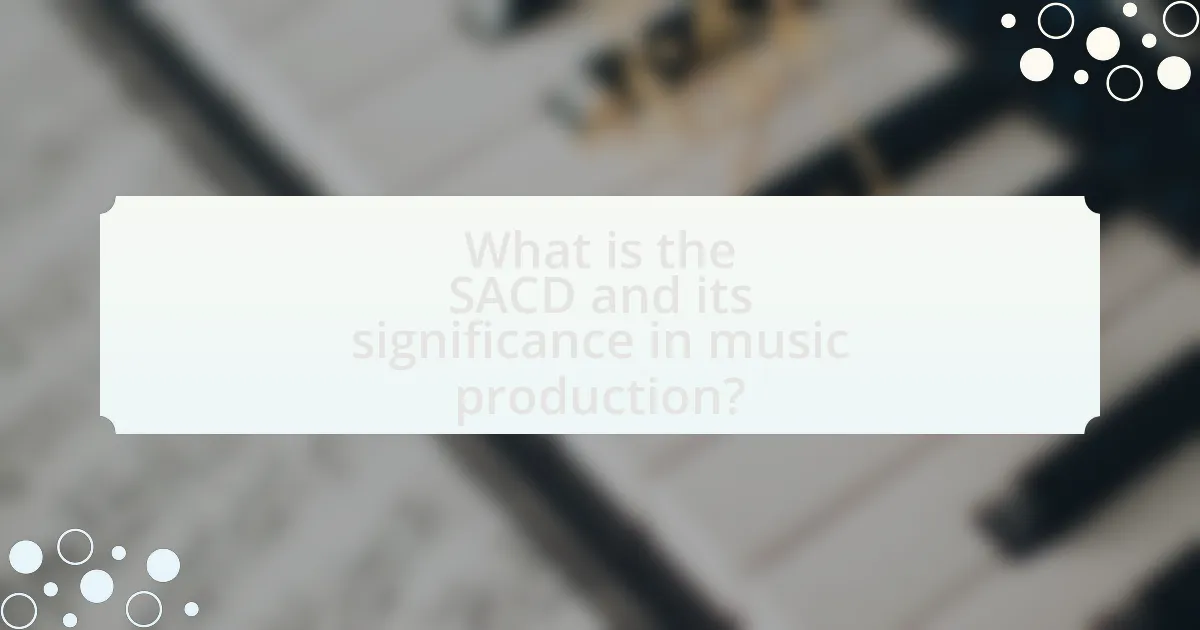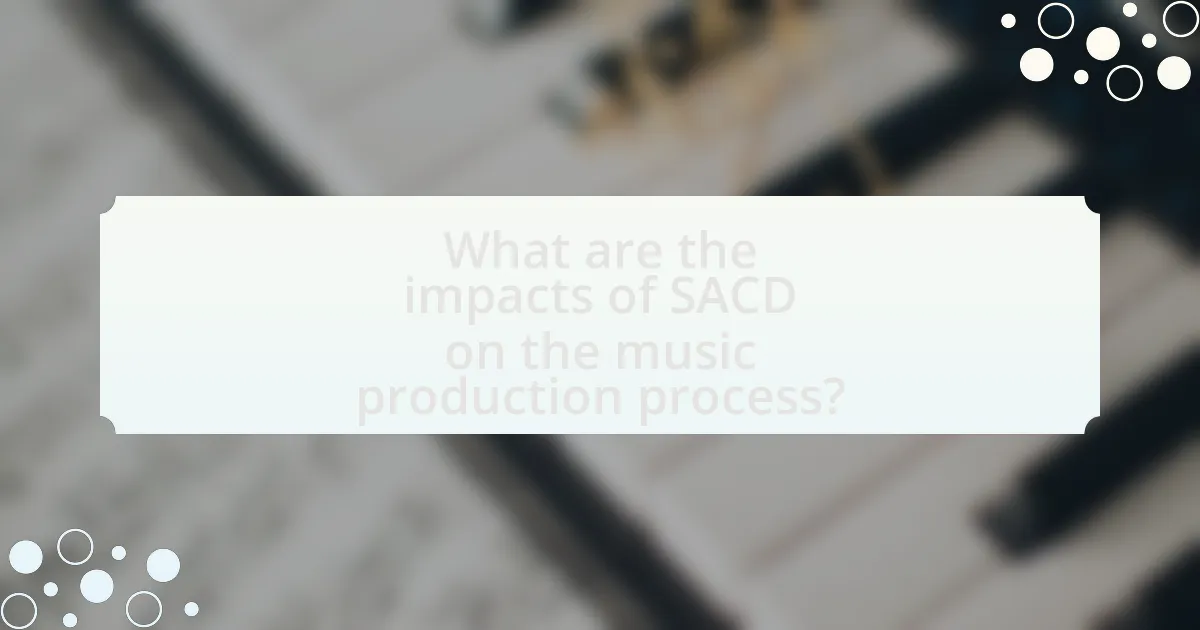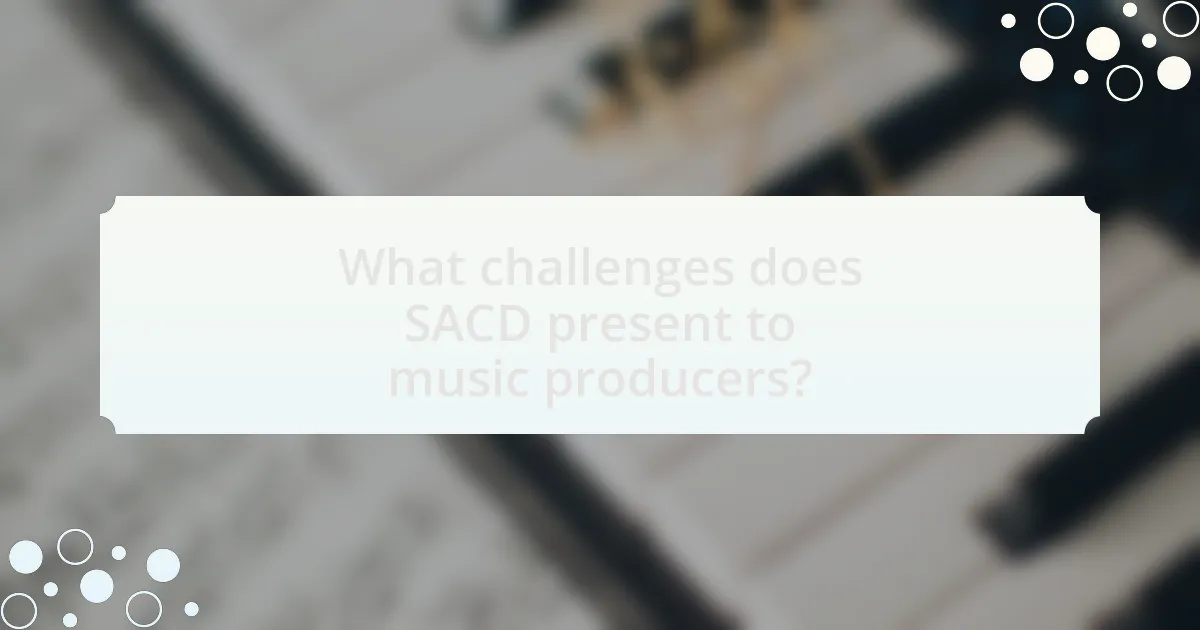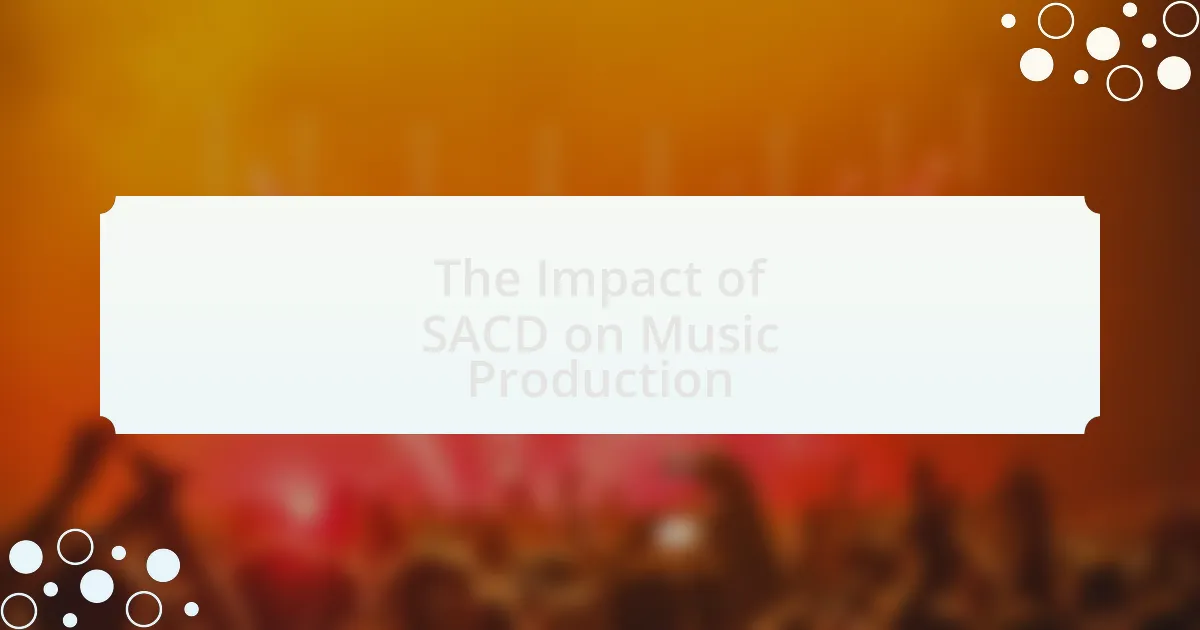The Super Audio CD (SACD) is a high-resolution audio format developed by Sony and Philips, introduced in 1999, that significantly enhances music production through superior sound quality and multi-channel audio capabilities. This article explores the technical specifications that differentiate SACD from traditional audio formats, such as its use of Direct Stream Digital (DSD) encoding, which allows for greater dynamic range and detail. It also examines the implications of SACD on recording techniques, mixing, and mastering processes, as well as the challenges and costs associated with its production. Additionally, the article discusses the market reception of SACD and its influence on music production decisions, highlighting best practices for producers working with this format.
What is the SACD and its significance in music production?

The SACD, or Super Audio CD, is a high-resolution audio format developed by Sony and Philips, introduced in 1999. Its significance in music production lies in its ability to deliver superior sound quality compared to standard CDs, utilizing a DSD (Direct Stream Digital) encoding process that captures audio at a higher sampling rate and bit depth. This results in a more accurate and detailed reproduction of sound, which is particularly beneficial for classical music and other genres that demand high fidelity. The SACD format supports multi-channel audio, allowing for immersive listening experiences, which has influenced the production techniques used by artists and producers aiming for enhanced audio quality in their recordings.
How does SACD differ from traditional audio formats?
SACD, or Super Audio CD, differs from traditional audio formats primarily in its ability to deliver higher audio quality through a different encoding method. While traditional formats like CDs use Pulse Code Modulation (PCM) at a 16-bit/44.1 kHz resolution, SACD employs Direct Stream Digital (DSD) encoding, which operates at a 1-bit resolution with a sampling rate of 2.8224 MHz. This allows SACD to capture a broader frequency range and dynamic range, resulting in a more detailed and immersive listening experience. The DSD format is capable of reproducing sound that is closer to the original analog recording, which is a significant advantage over conventional formats.
What technical specifications set SACD apart?
SACD, or Super Audio CD, is distinguished by its use of Direct Stream Digital (DSD) encoding, which operates at a sampling rate of 2.8224 MHz, significantly higher than the 44.1 kHz used in standard CDs. This high-resolution audio format allows for a greater dynamic range and improved sound quality, making it particularly appealing for audiophiles. Additionally, SACD supports multi-channel audio, enabling a surround sound experience that standard CDs do not offer. The combination of DSD encoding and multi-channel capabilities sets SACD apart in the realm of high-fidelity music production.
How does SACD enhance audio quality compared to CDs?
SACD enhances audio quality compared to CDs by utilizing a higher sampling rate and bit depth, which allows for greater detail and dynamic range in sound reproduction. Specifically, SACD employs a sampling rate of 2.8224 MHz and a 1-bit DSD (Direct Stream Digital) format, while CDs use a 44.1 kHz sampling rate and 16-bit PCM (Pulse Code Modulation). This significant difference in technology results in SACD providing a more accurate and immersive listening experience, capturing nuances in music that CDs cannot. Studies have shown that listeners often perceive SACD recordings as having superior clarity and depth, validating the advantages of SACD over traditional CDs.
Why was SACD developed and what needs does it address?
SACD, or Super Audio CD, was developed to enhance audio quality and provide a superior listening experience compared to standard CDs. It addresses the need for high-resolution audio formats that can deliver better sound fidelity, capturing a wider frequency range and dynamic range, which is particularly important for audiophiles and music professionals. The introduction of SACD in 1999 by Sony and Philips aimed to meet the growing demand for high-quality music reproduction in an era where digital formats were becoming increasingly popular.
What limitations of previous formats led to the creation of SACD?
The limitations of previous formats that led to the creation of SACD include inadequate audio resolution and the inability to deliver high-fidelity sound. Traditional CD formats, which utilized 16-bit/44.1 kHz audio, restricted dynamic range and frequency response, failing to meet the demands of audiophiles seeking superior sound quality. Additionally, the lack of multi-channel audio capabilities in standard CDs limited the immersive listening experience. SACD was developed to address these shortcomings by offering a higher resolution of 1-bit/2.8224 MHz audio through Direct Stream Digital (DSD) technology, enabling a more accurate and richer sound reproduction. This advancement allowed for both stereo and multi-channel formats, significantly enhancing the listening experience compared to previous formats.
How does SACD cater to audiophiles and music producers?
SACD caters to audiophiles and music producers by providing high-resolution audio quality that surpasses standard CD formats. This format supports multi-channel audio, allowing for a more immersive listening experience, which is particularly appealing to audiophiles seeking superior sound fidelity. Additionally, SACD utilizes Direct Stream Digital (DSD) technology, which captures audio at a higher sampling rate than traditional PCM formats, resulting in clearer and more detailed sound reproduction. Music producers benefit from SACD’s ability to deliver a wider dynamic range and enhanced tonal accuracy, enabling them to create and mix music with greater precision. The combination of these features makes SACD a preferred choice for high-end audio enthusiasts and professionals in the music industry.
What are the impacts of SACD on the music production process?

SACD, or Super Audio CD, significantly impacts the music production process by enhancing audio quality and providing a multi-channel sound experience. This format allows producers to capture a wider dynamic range and higher sampling rates compared to standard CDs, resulting in more detailed and immersive sound. The ability to mix in multi-channel formats enables artists to create a more spatial and engaging listening experience, which can influence creative decisions during production. Additionally, SACD’s DSD (Direct Stream Digital) encoding method offers a different approach to mastering, requiring producers to adapt their techniques to optimize the format’s unique characteristics. These factors collectively contribute to a more refined and innovative music production process.
How has SACD influenced recording techniques?
SACD has influenced recording techniques by promoting higher resolution audio formats and multi-channel sound. This advancement has led recording engineers to adopt more sophisticated microphone placements and mixing techniques to fully utilize the capabilities of SACD’s DSD (Direct Stream Digital) format. The necessity for capturing a more nuanced soundstage has encouraged the use of advanced recording equipment and techniques, such as high-quality analog-to-digital converters and improved acoustics in recording environments. As a result, SACD has driven the industry towards a focus on fidelity and immersive listening experiences, reshaping how music is produced and recorded.
What changes in studio equipment are necessary for SACD production?
To produce Super Audio CDs (SACDs), studios must upgrade to equipment capable of handling high-resolution audio formats, specifically DSD (Direct Stream Digital) recording technology. This requires digital audio converters that support DSD, as standard PCM (Pulse Code Modulation) converters are insufficient for SACD production. Additionally, studios need compatible mixing consoles and software that can process DSD signals, ensuring fidelity and quality in the final product. The necessity for higher-quality microphones and preamps also arises, as capturing the nuances of high-resolution audio demands superior recording equipment. These changes are essential to meet the SACD’s specifications for audio quality, which is significantly higher than that of traditional CDs.
How do producers adapt their workflows for SACD?
Producers adapt their workflows for SACD by incorporating high-resolution audio formats and multi-channel mixing techniques. This adaptation involves using specialized software and hardware that support DSD (Direct Stream Digital) recording, which is essential for SACD production. Additionally, producers often focus on creating immersive soundscapes, utilizing surround sound capabilities to enhance the listening experience. The need for meticulous attention to detail in audio quality and spatial arrangement is critical, as SACD aims to provide superior sound fidelity compared to traditional formats.
What are the implications of SACD on mixing and mastering?
SACD, or Super Audio CD, significantly influences mixing and mastering by providing a higher resolution audio format that supports multi-channel sound. This capability allows audio engineers to create more immersive listening experiences, as they can utilize the additional channels to enhance spatial effects and depth in the mix. Furthermore, SACD’s higher bit depth and sample rate (up to 24-bit/192 kHz) enable greater dynamic range and detail, which can lead to more nuanced mastering decisions. The implications of these features necessitate a shift in traditional mixing and mastering techniques, as engineers must adapt to the increased fidelity and complexity that SACD offers, ensuring that the final product fully exploits the format’s capabilities.
How does SACD affect the mixing process compared to other formats?
SACD, or Super Audio CD, affects the mixing process by allowing for higher resolution audio and multi-channel sound, which enhances the spatial quality and detail in the mix. This capability enables sound engineers to create more immersive listening experiences compared to standard formats like CD or MP3, which typically have lower bit rates and limited channel configurations. The increased dynamic range and frequency response of SACD, which can reach up to 24-bit/192 kHz, allows for finer adjustments in mixing, resulting in a more nuanced final product. This is supported by the fact that SACD’s DSD (Direct Stream Digital) format captures audio in a way that preserves more of the original sound’s characteristics, making it preferable for high-fidelity music production.
What mastering techniques are unique to SACD production?
Mastering techniques unique to SACD production include DSD (Direct Stream Digital) encoding, which captures audio at a higher sampling rate than traditional PCM (Pulse Code Modulation). This technique allows for a more accurate representation of sound, resulting in greater detail and dynamic range. Additionally, SACD mastering often employs a hybrid format that combines both DSD and PCM tracks, enabling compatibility with standard CD players while preserving the high-resolution audio quality for SACD players. The use of specialized mastering tools and processes tailored for DSD, such as noise shaping and filtering techniques, further enhances the audio fidelity unique to SACD production.
What challenges does SACD present to music producers?

SACD presents several challenges to music producers, primarily due to its complex technical requirements and limited market penetration. The high-resolution audio format necessitates specialized equipment for both production and playback, which can increase costs and complicate the production process. Additionally, the need for multi-channel mixing and mastering can require more time and expertise compared to traditional stereo formats. Furthermore, the relatively small consumer base for SACD limits the potential audience for releases, making it a less attractive option for producers focused on maximizing reach and sales.
What are the technical challenges of producing SACD content?
Producing SACD content involves several technical challenges, primarily related to the high-resolution audio format and its specific requirements. One significant challenge is the need for specialized equipment, such as DSD (Direct Stream Digital) converters, which are essential for capturing and processing audio at the required sampling rates of 2.8 MHz or higher. Additionally, the production process must accommodate the dual-layer structure of SACDs, which includes both a standard CD layer and a high-resolution layer, complicating the mastering and replication processes.
Another challenge is ensuring compatibility with various playback systems, as not all players support SACD formats, necessitating careful consideration during production to maintain audio quality across different devices. Furthermore, the limited market for SACD compared to traditional formats can impact the investment in production resources, making it less economically viable for some labels. These factors collectively contribute to the complexity of producing SACD content effectively.
How do compatibility issues with playback devices affect SACD production?
Compatibility issues with playback devices significantly impact SACD production by limiting the audience that can access the high-resolution audio format. SACDs are designed to be played on specific players that support both standard CD and SACD formats; however, many consumers still use older CD players that do not support SACD. This limitation can lead producers to prioritize compatibility with standard CD formats, potentially compromising the audio quality and features that SACD offers. According to a study by the Audio Engineering Society, the lack of widespread SACD player adoption has resulted in lower sales and interest in SACD releases, which directly influences production decisions and resource allocation in the music industry.
What are the costs associated with SACD production?
The costs associated with SACD production typically range from $1,000 to $5,000 per title, depending on various factors. These costs include expenses for mastering, which can be around $500 to $2,000, and the physical manufacturing of discs, which may cost between $1,000 and $3,000 for a minimum order. Additional costs may arise from artwork design, packaging, and distribution, which can further increase the overall budget. The investment in SACD production is justified by its superior audio quality and the potential for higher sales in niche markets, as SACDs appeal to audiophiles and collectors.
How does the market reception of SACD impact music production decisions?
The market reception of SACD significantly influences music production decisions by determining the resources allocated to high-resolution audio formats. When SACD sales are strong, record labels are more likely to invest in producing albums in this format, as evidenced by the initial surge in SACD releases in the early 2000s, which coincided with positive consumer feedback and sales figures. Conversely, a decline in market interest leads to reduced investment in SACD production, as seen in the subsequent years when many labels shifted focus back to standard CD formats due to lower demand for SACDs. This cyclical relationship between market reception and production choices underscores the importance of consumer preferences in shaping the audio landscape.
What trends in consumer preferences influence SACD production?
Trends in consumer preferences that influence SACD production include a growing demand for high-resolution audio and a preference for physical media over digital formats. As audiophiles increasingly seek superior sound quality, SACD’s capability to deliver multi-channel and high-definition audio becomes appealing. Additionally, the resurgence of interest in vinyl and other physical formats indicates a consumer shift towards tangible music collections, prompting producers to invest in SACD releases. This trend is supported by market research showing that high-fidelity formats are gaining traction among music enthusiasts, leading to a more significant focus on SACD production in the industry.
How do sales figures for SACD compare to other formats?
Sales figures for SACD are significantly lower compared to other formats like CD and digital downloads. While SACD was introduced in 1999 and aimed to provide higher audio quality, its sales have consistently lagged behind CDs, which sold over 200 billion units globally by 2020. In contrast, SACD sales have been estimated at around 10 million units, indicating a niche market. Digital formats, including streaming services, have also surpassed SACD, with streaming revenue reaching $12.2 billion in 2020 alone, highlighting the preference for more accessible formats among consumers.
What best practices should producers follow when working with SACD?
Producers should prioritize high-resolution audio formats and proper mastering techniques when working with SACD. Utilizing a DSD (Direct Stream Digital) workflow ensures that the audio retains its quality throughout the production process. Additionally, producers should be mindful of the stereo and multi-channel mixing capabilities of SACD, as this format allows for immersive sound experiences. It is also essential to maintain a clean signal path and use high-quality converters to prevent degradation of audio quality. Following these practices enhances the overall listening experience and leverages the unique advantages of SACD technology.
How can producers ensure optimal audio quality in SACD recordings?
Producers can ensure optimal audio quality in SACD recordings by utilizing high-resolution audio formats and employing meticulous recording techniques. High-resolution audio formats, such as DSD (Direct Stream Digital), allow for greater detail and dynamic range, which are essential for capturing the nuances of sound. Additionally, producers should focus on using high-quality microphones and preamps, as well as maintaining proper acoustics in the recording environment to minimize unwanted noise and reflections.
Furthermore, careful mixing and mastering processes are crucial; these should include using specialized SACD mastering tools that preserve the integrity of the audio during the final stages. Research indicates that SACD’s ability to reproduce sound frequencies beyond the standard CD range contributes to a more immersive listening experience, reinforcing the importance of these practices in achieving optimal audio quality.
What resources are available for producers new to SACD production?
Producers new to SACD production can access various resources, including online courses, industry forums, and technical manuals. Online platforms like Coursera and Udemy offer courses specifically focused on SACD production techniques, while forums such as Gearslutz provide community support and discussions on best practices. Additionally, technical manuals from manufacturers of SACD equipment, such as Sony, offer detailed guidance on the production process. These resources collectively equip producers with the necessary knowledge and skills to effectively engage in SACD production.

Leave a Reply